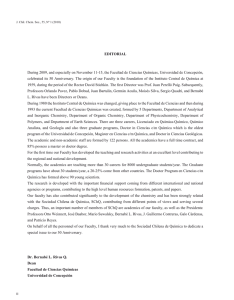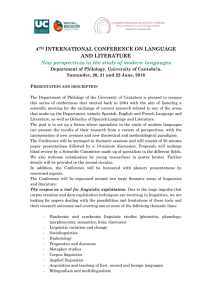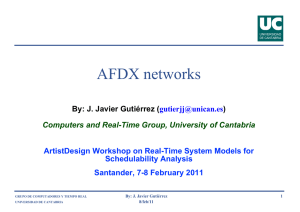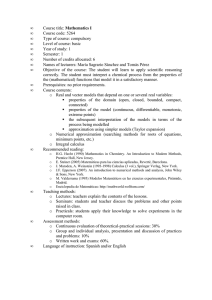Sistemas Distribuidos de Tiempo Real
Anuncio
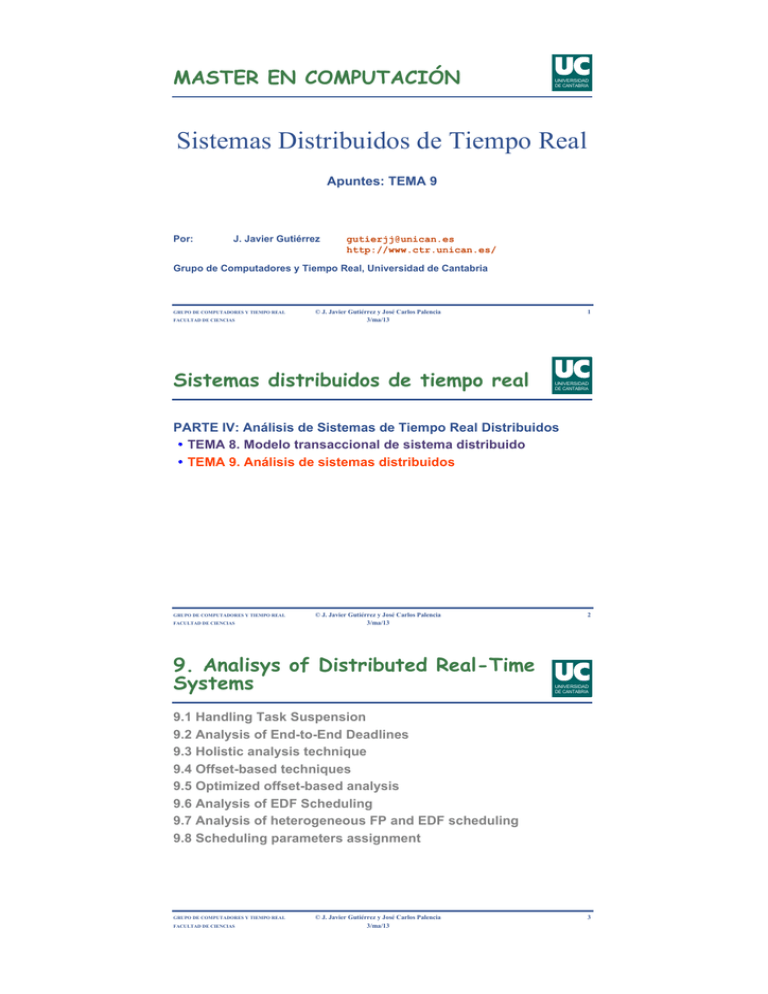
MASTER EN COMPUTACIÓN UNIVERSIDAD DE CANTABRIA Sistemas Distribuidos de Tiempo Real Apuntes: TEMA 9 Por: J. Javier Gutiérrez gutierjj@unican.es http://www.ctr.unican.es/ Grupo de Computadores y Tiempo Real, Universidad de Cantabria GRUPO DE COMPUTADORES Y TIEMPO REAL FACULTAD DE CIENCIAS © J. Javier Gutiérrez y José Carlos Palencia 3/ma/13 Sistemas distribuidos de tiempo real 1 UNIVERSIDAD DE CANTABRIA PARTE IV: Análisis de Sistemas de Tiempo Real Distribuidos • TEMA 8. Modelo transaccional de sistema distribuido • TEMA 9. Análisis de sistemas distribuidos GRUPO DE COMPUTADORES Y TIEMPO REAL FACULTAD DE CIENCIAS © J. Javier Gutiérrez y José Carlos Palencia 3/ma/13 9. Analisys of Distributed Real-Time Systems 2 UNIVERSIDAD DE CANTABRIA 9.1 Handling Task Suspension 9.2 Analysis of End-to-End Deadlines 9.3 Holistic analysis technique 9.4 Offset-based techniques 9.5 Optimized offset-based analysis 9.6 Analysis of EDF Scheduling 9.7 Analysis of heterogeneous FP and EDF scheduling 9.8 Scheduling parameters assignment GRUPO DE COMPUTADORES Y TIEMPO REAL FACULTAD DE CIENCIAS © J. Javier Gutiérrez y José Carlos Palencia 3/ma/13 3 9.1 Handling Task Suspension UNIVERSIDAD DE CANTABRIA In many systems a task suspends itself waiting for a response from a remote resource. Analysis of the suspending task: we can treat the suspension interval in two different (pessimistic) ways: • treat the suspension time as execution time, • or, treat each portion of the response as a different event. Analysis of lower priority tasks: treat each portion of the response as a different event, but: • include the jitter effect of the second portion, or eliminate jitter. Analysis with offsets can also be used for suspending tasks - less pessimism introduced © J. Javier Gutiérrez y José Carlos Palencia 3/ma/13 GRUPO DE COMPUTADORES Y TIEMPO REAL FACULTAD DE CIENCIAS 4 Example of a Suspending Task: CPU-1 UNIVERSIDAD DE CANTABRIA CPU-2 Task-3 Task-1 Serial Line Task-5 Task-2 Task-4 © J. Javier Gutiérrez y José Carlos Palencia 3/ma/13 GRUPO DE COMPUTADORES Y TIEMPO REAL FACULTAD DE CIENCIAS 5 Task parameters UNIVERSIDAD DE CANTABRIA Tasks 1, 2, 3, and 5 are periodic, and task 4 is a server task Task Ci Ti Di Pi 1 4 20 20 High 2 20+30 150 150 Low 3 5 30 30 High 4 15 - - Medium 5 100 200 200 Low The transmission times in the serial line: 25 and 34 ms., respectively for the request and the reply message. The end-to-end deadline for task-2 is 150 ms GRUPO DE COMPUTADORES Y TIEMPO REAL FACULTAD DE CIENCIAS © J. Javier Gutiérrez y José Carlos Palencia 3/ma/13 6 Solution with Suspending Task UNIVERSIDAD DE CANTABRIA Analysis in CPU-1: • treat suspension as execution time: a -----k C 1 + C 21 + M 1 + E 4 + M 2 + C 22 = 165ms T1 E2 = • treat each portion as a different task: E 21 = a -----k C 1 + C 21 T1 E 22 = a -----k C 1 + C 22 T1 E 2 = E 21 + M 1 + E 4 + M 2 + E 22 = 145ms GRUPO DE COMPUTADORES Y TIEMPO REAL FACULTAD DE CIENCIAS © J. Javier Gutiérrez y José Carlos Palencia 3/ma/13 Notas: 7 UNIVERSIDAD DE CANTABRIA The response time for task-1 is equal to C1=4 ms. For the response time of task-2 we must take into account the suspension time, which is the transmission time of the request message (M1), plus the response time to task-4 (E4), and plus the transmission time for the reply message (M2). M1 and M2 are 25 and 34 ms. respectively, because the serial line is not used by any other task; otherwise a complete analysis should be performed for the communications line. E4 is 20 ms.; this value was obtained from the analysis of CPU-2, which is shown in the following slide. The response time for task-2 can be determined using two different approaches: • Treating the suspension time as execution time: in this case the result is 165 ms. • Treating each portion of task-2 as a different task, and adding the two response times plus the suspension time: in this case the result is 145 ms. Both results may be pessimistic, i.e., they represent upper bounds to the worst-case execution time. Therefore, we can take the smallest (145 ms.) as the worst-case response time. GRUPO DE COMPUTADORES Y TIEMPO REAL FACULTAD DE CIENCIAS © J. Javier Gutiérrez y José Carlos Palencia 3/ma/13 Solution (continued) 8 UNIVERSIDAD DE CANTABRIA Analysis in CPU-2: E 3 = C 3 = 5ms E4 = E5 = a -----k C 3 + C 4 = 20ms T3 a a k + E 21 + M 1 -----k C 3 + --------------------------------- C 4 + C 5 = 160ms T4 T3 The term E21+M1 incorporates the effect of jitter in the activation of task-4. GRUPO DE COMPUTADORES Y TIEMPO REAL FACULTAD DE CIENCIAS © J. Javier Gutiérrez y José Carlos Palencia 3/ma/13 9 Notas: UNIVERSIDAD DE CANTABRIA The analysis of CPU-2 is conventional, except that task-4 is activated with jitter. This jitter has a schedulability penalty on lower priority tasks (i.e., on task-5). The amount of jitter that the activation of task4 suffers is the variability of the first portion of task-2, and the request message. Supposing that both could sometimes be very short (near to zero) and in other occasions the worst case could happen (E21=28 ms. and M1=25 ms.), the total jitter could be 53 ms. Notice that if we had not included the jitter effect in the equations, the result for task 5 would have been 140 ms., less that the actual worst-case that is 160 ms. GRUPO DE COMPUTADORES Y TIEMPO REAL FACULTAD DE CIENCIAS © J. Javier Gutiérrez y José Carlos Palencia 3/ma/13 9.2. End-to-End Deadlines 10 UNIVERSIDAD DE CANTABRIA It is possible to add response times in different resources to find out the worst-case end-to-end response time The portions of the distributed response after the first are not initiated periodically. We can use two approaches: • Analyze the effect of jitter - the analysis is complex, because jitter in one resource affects response times in other resources, and viceversa • Or eliminate jitter by using purely periodic activation or a sporadic server The analysis of the network is done like the analysis in a CPU, but: • the scheduling policy is usually different than in the CPUs GRUPO DE COMPUTADORES Y TIEMPO REAL FACULTAD DE CIENCIAS © J. Javier Gutiérrez y José Carlos Palencia 3/ma/13 Notas: 11 UNIVERSIDAD DE CANTABRIA The main problem that appears in a distributed system when a response is comprised of portions that run in different resources, is that all portions except the first are not activated periodically. Since each portion is activated when its predecessor has finished, it has jitter in its activation, which influences the response time of lower priority tasks. We can use two approaches to handle jitter: • Analyze the effect that jitter has on the schedulability of lower priority responses. We must take into account that the jitter in one resource influences the response times in that resource, which in turn influences the jitter in other resources. However, since the effect of increasing the jitter can only increase the response times, we can apply the schedulability equations iteratively, first assuming that there is no jitter, and then using the jitter from the previous iteration, until we reach a stable result. • The second approach consists of eliminating jitter by activating each portion of the response at periodic intervals. These intervals are calculated so that when one portion is started, there is guarantee that the previous portion had already completed. The same effect can be used by scheduling each portion of the response with a sporadic server, that will guarantee that the effects on lower priority tasks are not worse than those of an equivalent periodic task. The schedulability of LANs is usually determined in the same way as in a CPU: messages are treated like tasks, and message transmission times are like task execution times. However, we must be careful, because most LANs do not operate like CPUs, in a priority preemptive way. The analysis must take into account the scheduling policy of the LAN. GRUPO DE COMPUTADORES Y TIEMPO REAL FACULTAD DE CIENCIAS © J. Javier Gutiérrez y José Carlos Palencia 3/ma/13 12 Analysis of End-to-End Deadlines UNIVERSIDAD DE CANTABRIA The analysis can be done in two different ways: • Holistic analysis: use the schedulability analysis for single processor systems, as if all resources were independent: - Jitter depends on response times - Response times depend on jitter - Because the dependency of the response time on jitter is monotonic, we can start with zero jitter and then iterate over the analysis until a stable solution is achieved - This analysis is pessimistic • Using task offsets: - More complex analysis - Much less pessimistic GRUPO DE COMPUTADORES Y TIEMPO REAL FACULTAD DE CIENCIAS © J. Javier Gutiérrez y José Carlos Palencia 3/ma/13 Notas: 13 UNIVERSIDAD DE CANTABRIA The analysis can be done in two different ways: • Using the schedulability analysis for single processor systems, as if all resources were independent. The problem with this analysis is that jitter depends on response times, and the response times in turn depend on jitter. Because the dependency of the response time on jitter is monotonic, we can start with zero jitter and then iterate over the analysis until a stable solution is achieved. This analysis is pessimistic, because we are assuming that tasks encounter a critical instant in all CPUs and networks, but this may not be possible in practice because the execution of tasks is not independent. Using task offsets: • This is a much more complex analysis, that takes into account the interactions among tasks through the mechanism of considering task offsets. The results of this analysis are much less pessimistic than with the assumption of independent tasks. GRUPO DE COMPUTADORES Y TIEMPO REAL FACULTAD DE CIENCIAS © J. Javier Gutiérrez y José Carlos Palencia 3/ma/13 9.3. Holistic analysis technique 14 UNIVERSIDAD DE CANTABRIA Mainly developed at the University of York Each resource is analyzed separately (CPU’s and communication networks): • all activations after the first have “jitter” • jitter in one action is considered equal to the worst-case response time of the previous actions • analysis in one resource affects response times in other resources • the analysis is repeated iteratively, until a stable solution is achieved • the method converges because of the monotonic relation between jitters and response times GRUPO DE COMPUTADORES Y TIEMPO REAL FACULTAD DE CIENCIAS © J. Javier Gutiérrez y José Carlos Palencia 3/ma/13 15 Analysis in the distributed system UNIVERSIDAD DE CANTABRIA algorithm WCRT is begin initialize jitter terms to zero loop calculate worst-case response times; calculate new jitters, equal to response times of preceding actions exit when not schedulable or no variation since last iteration; end loop; end WCRT Assumption: Ji = Ri-Rbi , Rbi = best-case response time=0 GRUPO DE COMPUTADORES Y TIEMPO REAL FACULTAD DE CIENCIAS © J. Javier Gutiérrez y José Carlos Palencia 3/ma/13 16 Pessimism in holistic analysis UNIVERSIDAD DE CANTABRIA Holistic analysis technique assumes independent task activations in each resource CPU-1 CPU-2 Task-3 Task-1 Task-5 m1 Task-2 task21 task22 Serial Line Task-4 m2 GRUPO DE COMPUTADORES Y TIEMPO REAL FACULTAD DE CIENCIAS © J. Javier Gutiérrez y José Carlos Palencia 3/ma/13 Independent task analysis 17 UNIVERSIDAD DE CANTABRIA Execution timeline for task22 in previous example: task-1 task21 task22 Response time for task-2: • includes times for task21, m1, task-4, m2 and task22 • total is 270 GRUPO DE COMPUTADORES Y TIEMPO REAL FACULTAD DE CIENCIAS © J. Javier Gutiérrez y José Carlos Palencia 3/ma/13 18 9.4. Analysis with offsets UNIVERSIDAD DE CANTABRIA Developed by Tindell, at the University of York: • The exact analysis is intractable • An upper-bound approximation provides good results (equal to exact analysis in 93% of tested cases) Main limitations: • Offsets are static: - not applicable to general distributed transactions • Offsets are less than the task periods: - for distributed systems, deadlines would need to be smaller than or equal to the task periods Extended by Palencia (1998) to address these limitations GRUPO DE COMPUTADORES Y TIEMPO REAL FACULTAD DE CIENCIAS © J. Javier Gutiérrez y José Carlos Palencia 3/ma/13 19 Offset-based techniques UNIVERSIDAD DE CANTABRIA The objetive is reduce the pessimism of the worst-case analysis in multiprocessor and distributed systems: • by considering offsets in the analysis, • offsets can be larger than task periods; - this is important if deadlines > task periods • offsets can be static or dynamic: - offsets are dynamic in distributed systems - also in tasks that suspend themselves This enhancement comes “for free”, as there is no change to the application, • although better results can be obtained if best-case execution times are measured GRUPO DE COMPUTADORES Y TIEMPO REAL FACULTAD DE CIENCIAS © J. Javier Gutiérrez y José Carlos Palencia 3/ma/13 20 Using offsets to reduce pessimism UNIVERSIDAD DE CANTABRIA Execution timeline for analysis of task-2: task-1 task-2 t=145 serial line task-3 task-4 GRUPO DE COMPUTADORES Y TIEMPO REAL FACULTAD DE CIENCIAS © J. Javier Gutiérrez y José Carlos Palencia 3/ma/13 21 System model with offsets T1 T1 R12 R11 1 11 12 21 2 UNIVERSIDAD DE CANTABRIA 21 T2 22 22 Rn2 Rn3 Tn Rn1 n n1 n2 In addition, each task may have jitter n3 © J. Javier Gutiérrez y José Carlos Palencia 3/ma/13 GRUPO DE COMPUTADORES Y TIEMPO REAL FACULTAD DE CIENCIAS 22 Exact analysis with static offsets UNIVERSIDAD DE CANTABRIA Contribution of task ij to the response time of lower priority tasks: • Set 0: activations that occur before the critical instant and that cannot occur inside the busy period • Set 1: activations that occur before or at the critical instant, and that may occur inside the busy period - Theorem 1: worst-case when they all occur at the critical instant - Theorem 2: worst-case when the first one experienced its maximum jitter • Set 2:activations that occur after the critical instant - Theorem 1: worst-case when they have zero jitter © J. Javier Gutiérrez y José Carlos Palencia 3/ma/13 GRUPO DE COMPUTADORES Y TIEMPO REAL FACULTAD DE CIENCIAS 23 Scenarios for calculating the worstcase contribution of ij UNIVERSIDAD DE CANTABRIA Scenario 1 ij Ti tc ij ij ij Ji Scenario 2 ij Ti tc ij ij ij Ji GRUPO DE COMPUTADORES Y TIEMPO REAL FACULTAD DE CIENCIAS © J. Javier Gutiérrez y José Carlos Palencia 3/ma/13 24 Upper bound approximation for worstcase analysis UNIVERSIDAD DE CANTABRIA Exact analysis is intractable: • The task that generates the worst-case contribution of a given transaction is unknown. • The analysis has to check all possible combinations of tasks Tindell developed an upper bound approximation: • For each transaction we consider a function that is the maximum of all the worst-case contributions considering each of the tasks of the transaction to be initiating the critical instant • This technique is pessimistic, but polynomial • In 93% of the tested cases, the response times were exact GRUPO DE COMPUTADORES Y TIEMPO REAL FACULTAD DE CIENCIAS © J. Javier Gutiérrez y José Carlos Palencia 3/ma/13 Analysis with dynamic offsets 25 UNIVERSIDAD DE CANTABRIA In many systems the offset may be dynamic: ij ij min ij max Example: task with a suspending operation 12 [Rbi1+Smin, Ri1+Smax] task12 task11 task1 Ri1 disk read S [Smin,Smax] GRUPO DE COMPUTADORES Y TIEMPO REAL FACULTAD DE CIENCIAS © J. Javier Gutiérrez y José Carlos Palencia 3/ma/13 Analysis with dynamic offsets (cont’d) 26 UNIVERSIDAD DE CANTABRIA Dynamic offsets can be modeled with static offsets and jitter: • Equivalent offset: ' ij = ij min • Equivalent jitter: J' ij = J ij + ij max – ij min The problem is that now offsets depend on response times, and response times depend on offsets • The solution is to apply the analysis iteratively, starting with response times = zero, until a stable solution is achieved • We call this algorithm WCDO GRUPO DE COMPUTADORES Y TIEMPO REAL FACULTAD DE CIENCIAS © J. Javier Gutiérrez y José Carlos Palencia 3/ma/13 27 Analysis of multiprocessor and distributed systems UNIVERSIDAD DE CANTABRIA Distributed transaction i i1 i2 i3 i4 i5 Dynamic offsets in distributed transactions can also be modeled with static offsets and jitter: • Equivalent offset: b ' ij = ij min = R ij – 1 • Equivalent jitter: b J' ij = J ij + ij max – ij min = R ij – 1 – R ij – 1 © J. Javier Gutiérrez y José Carlos Palencia 3/ma/13 GRUPO DE COMPUTADORES Y TIEMPO REAL FACULTAD DE CIENCIAS 28 Analysis with offsets UNIVERSIDAD DE CANTABRIA If we apply the analysis with offsets to the suspending task of the example in slice 5, we get the following results: Task Di Ri 1 20 4 2 150 145 3 30 5 4 - - 5 200 140 © J. Javier Gutiérrez y José Carlos Palencia 3/ma/13 GRUPO DE COMPUTADORES Y TIEMPO REAL FACULTAD DE CIENCIAS 29 Comparison with holistic analysis: 1 processor 5 UNIVERSIDAD DE CANTABRIA Analysis for: 1 processor 10 transactions 10 tasks per transaction 4,5 Rindep/RWCDO 4 3,5 3 2,5 2 Tmax/Tmin = 10 Tmax/Tmin = 100 Tmax/Tmin=1000 1,5 1 0 10 20 30 40 50 60 70 80 90 % Utilization GRUPO DE COMPUTADORES Y TIEMPO REAL FACULTAD DE CIENCIAS © J. Javier Gutiérrez y José Carlos Palencia 3/ma/13 30 Comparison with four processors, and best-case=0 UNIVERSIDAD DE CANTABRIA 1,5 Analysis for: 4 processors 10 transactions 12 tasks per transaction best case = 0 1,45 1,4 Rindep/RWCDO 1,35 1,3 1,25 1,2 1,15 1,1 Tmax/Tmin = 10 Tmax/Tmin = 100 Tmax/Tmin = 1000 1,05 1 0 10 20 30 40 50 60 70 80 90 % Utilization © J. Javier Gutiérrez y José Carlos Palencia 3/ma/13 GRUPO DE COMPUTADORES Y TIEMPO REAL FACULTAD DE CIENCIAS 31 Comparison with four processors and best-case>0 5 Analysis for: 4 processors 10 transactions 12 tasks per transaction best case > 0 4,5 4 Rindep/RWCDO UNIVERSIDAD DE CANTABRIA 3,5 3 2,5 2 Tmax/Tmin = 10 Tmax/Tmin = 100 Tmax/Tmin = 1000 1,5 1 0 10 20 30 40 50 60 70 80 90 % Utilization © J. Javier Gutiérrez y José Carlos Palencia 3/ma/13 GRUPO DE COMPUTADORES Y TIEMPO REAL FACULTAD DE CIENCIAS Maximum utilization with 20 tasks per transaction 10 32 UNIVERSIDAD DE CANTABRIA Analysis for: 4 processors 5 transactions 20 tasks per transaction Tmax/Tmin=100 9 8 7 D/T 6 5 4 3 Independent tasks WCDO with best case=0 WCDO with best case > 0 2 1 0 0 10 20 30 40 50 60 70 80 90 Maximum schedulable utilization GRUPO DE COMPUTADORES Y TIEMPO REAL FACULTAD DE CIENCIAS © J. Javier Gutiérrez y José Carlos Palencia 3/ma/13 33 Maximum utilization with 12 tasks per transaction UNIVERSIDAD DE CANTABRIA 8 Analysis for: 4 processors 5 transactions 12 tasks per transaction Tmax/Tmin=100 7 6 D/T 5 4 3 2 Independent tasks WCDO with best case = 0 WCDO with best case > 0 1 0 0 10 20 30 40 50 60 70 80 90 Maximum schedulable utilization GRUPO DE COMPUTADORES Y TIEMPO REAL FACULTAD DE CIENCIAS © J. Javier Gutiérrez y José Carlos Palencia 3/ma/13 34 9.5. Optimized offset-based analysis UNIVERSIDAD DE CANTABRIA Offset-based analysis produces results that are much less pessimistic than other methods (i.e., holistic analysis) But offset-based analysis still has room for improvement • a high priority task that is preceded by a low priority task may not be able to execute before a medium priority task under analysis Prio=Low Prio=High Prio=High Prio=Low Prio=High Task-i1 Task-i2 Task-i3 Task-i4 Task-i5 Task under analysis Task-2 Prio=medium GRUPO DE COMPUTADORES Y TIEMPO REAL FACULTAD DE CIENCIAS © J. Javier Gutiérrez y José Carlos Palencia 3/ma/13 Objectives of optimized offset-based analysis 35 UNIVERSIDAD DE CANTABRIA To enhance the offset-based schedulability analysis by: • Eliminating from the analysis the effects of higher priority tasks that cannot execute due to precedence constraints • Eliminating the effects of the tasks that are preceded by the task under analysis These enhancements reduce much of the pessimism in the analysis of distributed systems GRUPO DE COMPUTADORES Y TIEMPO REAL FACULTAD DE CIENCIAS © J. Javier Gutiérrez y José Carlos Palencia 3/ma/13 36 Simulation results: response times 10 8 Analysis for: 1 processor 10 transactions 10 tasks per transaction Best case = 0 7 WCDOPS , = Rindep/R 9 UNIVERSIDAD DE CANTABRIA 10 WCDOPS , = 100 WCDOPS , = 1000 6 WCDO , WCDO , 5 WCDO , = 10 = 100 = 1000 4 3 2 1 0 5 10 15 20 25 30 35 40 45 50 % Utilization © J. Javier Gutiérrez y José Carlos Palencia 3/ma/13 GRUPO DE COMPUTADORES Y TIEMPO REAL FACULTAD DE CIENCIAS 37 Simulation results: response times UNIVERSIDAD DE CANTABRIA 3,5 Analysis for: 4 processors 10 transactions 12 tasks per transaction Best case > 0 3 WCDOPS , = 10 WCDOPS , = 100 Rindep/R 2,5 WCDOPS , = 1000 = 10 WCDO , = 100 WCDO , = 1000 WCDO , 2 1,5 1 0 5 10 15 20 25 30 35 40 45 50 % Utilization © J. Javier Gutiérrez y José Carlos Palencia 3/ma/13 GRUPO DE COMPUTADORES Y TIEMPO REAL FACULTAD DE CIENCIAS 38 Simulation results: utilization 40 Analysis for: 4 processors 5 transactions 20 tasks per transaction Tmax/Tmin = 100 30 Maximum utilization UNIVERSIDAD DE CANTABRIA 20 Independent tasks 10 WCDO with best case = 0 WCDOPS with best case = 0 WCDOPS with best case > 0 0 0 1 2 3 4 5 6 7 8 9 10 Relation D/T GRUPO DE COMPUTADORES Y TIEMPO REAL FACULTAD DE CIENCIAS © J. Javier Gutiérrez y José Carlos Palencia 3/ma/13 39 Simulation results: utilization 50 Analysis for: 4 processors 5 transactions 12 tasks per transaction Tmax/Tmin = 100 40 Maximum utilization UNIVERSIDAD DE CANTABRIA 30 20 Independent tasks WCDO with best case = 0 WCDOPS with best case = 0 WCDOPS with best case > 0 10 0 0 2 4 6 8 10 Relation D/T GRUPO DE COMPUTADORES Y TIEMPO REAL FACULTAD DE CIENCIAS © J. Javier Gutiérrez y José Carlos Palencia 3/ma/13 40 9.6. EDF Scheduling Policy UNIVERSIDAD DE CANTABRIA Each task i has a relative period, Ti, and a relative deadline assigned: Di Each task-i job j has an absolute activation time, ai,j, and an absolute deadline, di,j, used as the inverse of the job priority T1 D1 D1 D1 D1 task1 a1,1 d1,1 a1,2 d1,2 a1,3 d1,3 a1,4 T2 D2 D2 task2 a2,1 GRUPO DE COMPUTADORES Y TIEMPO REAL FACULTAD DE CIENCIAS d2,1 a2,2 d2,2 a2,3 © J. Javier Gutiérrez y José Carlos Palencia 3/ma/13 Optimality of EDF in monoprocessor 41 UNIVERSIDAD DE CANTABRIA In a system with only periodic independent tasks, with a preemptive scheduler, executing in a single processor • The EDF scheduling policy is optimal (Liu & Layland, 1973) • 100% utilization may be achieved GRUPO DE COMPUTADORES Y TIEMPO REAL FACULTAD DE CIENCIAS © J. Javier Gutiérrez y José Carlos Palencia 3/ma/13 42 Response Time Analysis for EDF in Monoprocessor Systems UNIVERSIDAD DE CANTABRIA Worst case response time of a task: found in a busy period in which all other tasks: • are released at the beginning of the busy period, • and have experienced their maximum jitter Differences with fixed priorities: • The task under analysis does not necessarily start with the busy period • The busy period is longer, because it involves all tasks © J. Javier Gutiérrez y José Carlos Palencia 3/ma/13 GRUPO DE COMPUTADORES Y TIEMPO REAL FACULTAD DE CIENCIAS 43 Response Time Analysis for EDF UNIVERSIDAD DE CANTABRIA Worst contribution of task i to the busy period at time t, when the deadline of the analyzed task, a, is D: Ji + D – di t+J W i t D = min ------------i ------------------------ + 1 C i T T i i 0 Worst completion time of activation p, if first activation at A: A A A w a p = pC a + W i w a p D p i a Worst response time if first activation is A: A A R p = w a p – A + J a – p – 1 T a © J. Javier Gutiérrez y José Carlos Palencia 3/ma/13 GRUPO DE COMPUTADORES Y TIEMPO REAL FACULTAD DE CIENCIAS Response time analysis in a single resource (cont’d) 44 UNIVERSIDAD DE CANTABRIA Set of potential critical instants; L is the longest busy period: = p – 1 T i – J i + d i L–J p = 1 -------------a- i a Ta Values of A to check: = x p – 1 T a – J a + d a x pT a – J a + d a A = x – p – 1 T a – J a + d a Worst-case response time A R a = max R p GRUPO DE COMPUTADORES Y TIEMPO REAL FACULTAD DE CIENCIAS L–J p = 1 -------------a- A Ta © J. Javier Gutiérrez y José Carlos Palencia 3/ma/13 45 EDF schedulers in distributed systems UNIVERSIDAD DE CANTABRIA Global EDF scheduling: • each task is assigned a global scheduling deadline that is referenced to the arrival of the event that releases the end-to-end flow, possibly in a different processing resource • it requires clock synchronization among all the processing resources involved Local EDF scheduling: • each task is assigned a local scheduling deadline that is referenced to the release time of its associated event in its own processing resource • it uses the local clock of each processing resource and clock synchronization is not necessary GRUPO DE COMPUTADORES Y TIEMPO REAL FACULTAD DE CIENCIAS © J. Javier Gutiérrez y José Carlos Palencia 3/ma/13 46 Holistic analysis for EDF in distributed systems UNIVERSIDAD DE CANTABRIA Developed by Spuri and suitable for global EDF schedulers • similar to the holistic analysis developed for fixed priorities at the University of York Each resource is analyzed separately (CPU’s and networks): - all activations after the first present “jitter” - jitter in one action is considered equal to the worst-case response time of the previous actions - analysis in one resource affects response times in other resources - the analysis is repeated, until a stable solution is achieved - the solution is pessimistic A holistic analysis for local EDF schedulers was proposed in Rivas et al 2010 GRUPO DE COMPUTADORES Y TIEMPO REAL FACULTAD DE CIENCIAS © J. Javier Gutiérrez y José Carlos Palencia 3/ma/13 47 Offset-based analysis for global EDF (Palencia, 2003) UNIVERSIDAD DE CANTABRIA Distributed transaction i i1 i2 i3 i4 i5 Dynamic offsets in distributed transactions can also be modeled with static offsets and jitter: • Equivalent offset: b ' ij = ij min = R ij – 1 • Equivalent jitter: b J' ij = J ij + ij max – ij min = R ij – 1 – R ij – 1 GRUPO DE COMPUTADORES Y TIEMPO REAL FACULTAD DE CIENCIAS © J. Javier Gutiérrez y José Carlos Palencia 3/ma/13 48 Comparison with holistic analysis: 1 processor 5 Analysis for: 1 processor 10 transactions 5 tasks per transaction 4,5 4 Rindep/ROffsets UNIVERSIDAD DE CANTABRIA 3,5 3 2,5 2 Tmax/Tmin = 10 Tmax/Tmin = 100 Tmax/Tmin=1000 1,5 1 0 10 20 30 40 50 60 70 80 90 % Utilization GRUPO DE COMPUTADORES Y TIEMPO REAL FACULTAD DE CIENCIAS © J. Javier Gutiérrez y José Carlos Palencia 3/ma/13 49 Comparison with four processors, and best-case=0 Rindep/ROffsets 4 UNIVERSIDAD DE CANTABRIA Analysis for: 4 processor 10 transactions 12 tasks per transaction best case = 0 3 2 Tmax/Tmin = 10 Tmax/Tmin = 100 Tmax/Tmin = 1000 1 0 10 20 30 40 50 60 % Utilization GRUPO DE COMPUTADORES Y TIEMPO REAL FACULTAD DE CIENCIAS © J. Javier Gutiérrez y José Carlos Palencia 3/ma/13 50 Comparison with four processors and best-case>0 5 Analysis for: 4 processor 10 transactions 12 tasks per transaction best case > 0 4 Rindep/ROffsets UNIVERSIDAD DE CANTABRIA 3 2 Tmax/Tmin = 10 Tmax/Tmin = 100 Tmax/Tmin = 1000 1 0 10 20 30 40 50 60 % Utilization GRUPO DE COMPUTADORES Y TIEMPO REAL FACULTAD DE CIENCIAS © J. Javier Gutiérrez y José Carlos Palencia 3/ma/13 51 Maximum utilization with 20 tasks per transaction 10 UNIVERSIDAD DE CANTABRIA Analysis for: 4 processors 5 transactions 20 tasks per transaction Tmax/Tmin=10 9 8 7 D/T 6 5 4 Independent tasks Offsets with best case=0 Offsets with best case > 0 3 2 1 0 0 10 20 30 40 50 60 70 Maximum schedulable utilization © J. Javier Gutiérrez y José Carlos Palencia 3/ma/13 GRUPO DE COMPUTADORES Y TIEMPO REAL FACULTAD DE CIENCIAS 52 Maximum utilization with 12 tasks per transaction 10 UNIVERSIDAD DE CANTABRIA Analysis for: 4 processors 5 transactions 12 tasks per transaction Tmax/Tmin=100 9 8 7 D/T 6 5 4 Independent tasks 3 Offsets with best case=0 2 Offsets with best case > 0 1 0 0 10 20 30 40 50 60 70 80 90 Maximum schedulable utilization GRUPO DE COMPUTADORES Y TIEMPO REAL FACULTAD DE CIENCIAS © J. Javier Gutiérrez y José Carlos Palencia 3/ma/13 53 Summary of Analysis Techniques Kind of Analysis Deadlines Number of processors Utilization test D=T 1 Response Time Analysis Arbitrary 1 Holistic Analysis Arbitrary Many Offset-Based Analysis Arbitrary Many Fixed Priorities UNIVERSIDAD DE CANTABRIA Local EDF Global EDF Distributed model also applicable to: • signal & wait synchronization • activities that suspend themselves (i.e., delays, I/O, ...) GRUPO DE COMPUTADORES Y TIEMPO REAL FACULTAD DE CIENCIAS © J. Javier Gutiérrez y José Carlos Palencia 3/ma/13 54 9.7 Analysis of heterogeneous FP and EDF scheduling ... ij-1 ij ij+1 UNIVERSIDAD DE CANTABRIA Pij SDij | Sdij ... J ij ij Rbij Rij ij Schedulability analysis techniques for FP and EDF can be combined using equivalent jitters and offsets: b J ij = J ij + m ax R ij – 1 ij – max R ij – 1 ij b ij = max R ij – 1 ij GRUPO DE COMPUTADORES Y TIEMPO REAL FACULTAD DE CIENCIAS © J. Javier Gutiérrez y José Carlos Palencia 3/ma/13 Heterogeneous RTA algorithm 55 UNIVERSIDAD DE CANTABRIA START Heterogeneous RTA Initialize J’ij=Jij, ’ij=ij, i, j i=1 j=1 Analysis of step ij (obtains Rbij, Rij) Calculate J’ij, ’ij Yesj++ More steps? No Yesi++ More end-to-end flows? No Yes Any change in Rbij or Rij? No END Heterogeneous RTA GRUPO DE COMPUTADORES Y TIEMPO REAL FACULTAD DE CIENCIAS © J. Javier Gutiérrez y José Carlos Palencia 3/ma/13 9.8 Scheduling parameters assignment 56 UNIVERSIDAD DE CANTABRIA PD (Proportional Deadline) • distributes deadlines proportionally to the worst-case execution times of the steps in the end-to-end flow NPD (Normalized Proportional Deadline) • similar to PD but normalizing it by the utilization of the processing resources Simulated Annealing: an optimization technique first used by Tindell, Burns, and Wellings for assigning priorities HOSPA (Heuristic Optimized Scheduling Parameters Assignment) • provides better and faster results for heterogeneous distributed systems, based on HOPA for fixed priotities and HOSDA for EDF GRUPO DE COMPUTADORES Y TIEMPO REAL FACULTAD DE CIENCIAS © J. Javier Gutiérrez y José Carlos Palencia 3/ma/13 57 HOSPA algorithm UNIVERSIDAD DE CANTABRIA It is based on • the distribution of the global deadlines of each end-to-end flow among the different steps that compose it, and • the iteration over the results of RTA to redistribute these deadlines Once each step is assigned what we will call a virtual deadline (VD), it is converted into • a priority (P) • a local scheduling deadline (Sd), or • a global scheduling deadline (SD) © J. Javier Gutiérrez y José Carlos Palencia 3/ma/13 GRUPO DE COMPUTADORES Y TIEMPO REAL FACULTAD DE CIENCIAS 58 HOSPA algorithm (cont’d) UNIVERSIDAD DE CANTABRIA START HOSPA Initial VDs assignment P Convert VDs Sd SD Heterogeneous RTA Met Stopping criterion? END HOSPA Not met New VDs assignment © J. Javier Gutiérrez y José Carlos Palencia 3/ma/13 GRUPO DE COMPUTADORES Y TIEMPO REAL FACULTAD DE CIENCIAS 59 Comparison of scheduling parameters assignment techniques UNIVERSIDAD DE CANTABRIA Results for an example with 5 processors and 8 end-to-end flows (variable length between 1 and 5 tasks) 83,7 D=Random (T,2NT) 71,8 72 98,1 D=2NT 88,7 89,1 83 D=NT 69,5 69,4 54,8 D=NT/2 49,5 49,8 42,9 40,4 40,3 D=T 30 GRUPO DE COMPUTADORES Y TIEMPO REAL FACULTAD DE CIENCIAS 40 50 60 70 80 ISEAverageMaximumSchedulableUtilization(%) © J. Javier Gutiérrez y José Carlos Palencia 3/ma/13 HOSPA NPD PD 90 100 60 Fixed Priority Assignment Techniques in MAST Technique Monoprocessor PD NPD Simulated Annealing HOSPA SingleProcessor FP SingleProcessor EDF UNIVERSIDAD DE CANTABRIA MultiProcessor FP MultiProcessor EDF MultiProcessor FP/EDF • Monoprocessor FP: - If deadlines within periods, DM - Otherwise, Audsley’s algorithm: iteratively apply analysis, successively ordering tasks by priority: O(n2) times the analysis GRUPO DE COMPUTADORES Y TIEMPO REAL FACULTAD DE CIENCIAS © J. Javier Gutiérrez y José Carlos Palencia 3/ma/13 61


